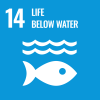
Determining manatee diets
HSWRI researchers performed the first isotope analysis of Florida manatees as a baseline to determine wild manatee diets. Manatees feed on a variety of plants in fresh, estuarine and marine habitats, but it’s difficult to determine their actual diets in the wild, since they usually eat in turbid water. Researchers analyzed skin samples from nine rescued manatees at SeaWorld over the course of a year during their rehabilitation to determine the link between food and the isotopes in their skin. This analysis allows for similar sampling on manatees in the wild to determine their diet. Subsequent research compared manatee isotopes from Belize, Puerto Rico, and Florida found that, although most manatees eat primarily seagrass, manatees from Florida’s Crystal River and Homosassa Springs fed primarily on freshwater vegetation. In 2021 and 2022, Florida manatees were dying at record numbers and the primary culprit was starvation. Isotope analysis can trace the changes in manatee diets for surviving manatees to determine how they survived and help prevent future starvation by identifying crucial habitats and improving conservation efforts.
Publications: Alves-Stanley, C.D. and G.A.J. Worthy. 2009. Carbon and nitrogen turnover rates and diet-tissue discrimination in Florida manatees (Trichechus manatus latirostris). The Journal of Experimental Biology 212:2349-2355.
Alves-Stanley, C.D. and G.A.J. Worthy. 2009. Carbon and nitrogen turnover rates and diet-tissue discrimination in Florida manatees (Trichechus manatus latirostris). The Journal of Experimental Biology 212:2349-2355.
Alves-Stanley, C.D. and G.A.J. Worthy. 2010. Feeding preferences of the West Indian manatee in Florida, Belize and Puerto Rico, as indicated by stable isotope analysis. Marine Ecology Progress Series 402:255-267.
